

The point to notice is that theses low centre frequencies now differ by approximately (1/24)th of an octave between the two methods. The base 10 values are at 10Hz and 1Hz of course. If we continue further down to 10Hz and 1Hz then the base 2 centre frequencies are 9.84313…Hz and 0.97656…Hz respectively. If we use the base 2 method and find the centre frequency of the third octave band 10 steps below we get 99.21257… Hz, but with base 10 we get exactly 100.0Hz. For (1/N)th octave the relationship is simply Where the centre frequency is the exact one not the preferred one. When working out the edge band frequencies for a 1/3 octave then these are respectively In both cases the nearest preferred frequency is 800Hz so that is what the band is called. Using base 10 the corresponding centre frequency is 794.3282…. This is not the case for the base 2 frequencies.Īs an example (using base 2) the theoretical centre frequency of the 1/3 octave below 1000 is found by dividing by 2^(1/3). One very good reason for using base 10 is that all the exact centre frequencies are the same for each decade. The base 2 one is simpler to use (and is often favoured by non-engineering programmers!), but the base 10 one is actually sounder numerically. For nearly all practical purposes both ratios are the same but tones at band edges can be interesting and may appear to be in different octave bands. This ratio may also be written as 2^(3/). The other method is the base 10 method where the ratio is given by 10^(3/). One scheme is the base2 method where the ratio between 2 exact centre frequencies is given by 2^(1/N) with N as 3 for 1/3 octaves and so on.
OCTAVE BAND ISO
There are two ISO and ANSI approved ways in which the exact centre frequencies may be defined. The basis of audio fractional octave bands is a frequency of 1000Hz. The ‘R’ is used to acknowledge the original work of Renard in the 1870’s. In BS2045 these preferred numbers are called the R5, R10, R20, R40 and R80 series.

They have been used in wide range of applications including capacitors & resistors, construction industry and retail packaging. Preferred numbers are not specific to third octave bands. Preferred Numbers were standardised in 1965 in British Standard BS2045:1965 Preferred Numbers and in ISO and ANSI versions in 1973. This work resulted in what are now known as Renard numbers. Charles Renard (1849–1905) was given the job of improving captive balloons used by the military to observe enemy positions. These date from the 19th century when Col. All you need are the octave band sound level measurements and the octave band APV figures from the hearing protector specifications.The “standard” centre frequencies for 1/3 octave bands are based upon the Preferred Numbers. You can use our Octave Band hearing protection calculator to carry out the above calculations and produce a simple report. NoiseMeters provides a range of online applications for calculating noise exposures along with other noise related calculators. So in this example, after all that work, these particular hearing protectors are inadequate. In the EU and the UK the regulations recommend adding a "real-world factor" of 4dB to account for poor fitting of hearing protectors. Now take each of the numbers on the bottom row, divide by 10 and anti-log: As there are only eight bands of interest for these calculations, it is easy enough to expand this to a usable form: Frequency (Hz)


 0 kommentar(er)
0 kommentar(er)
